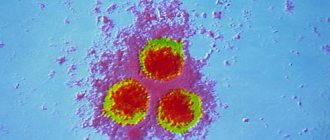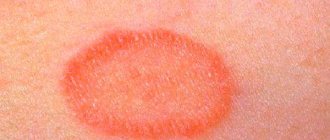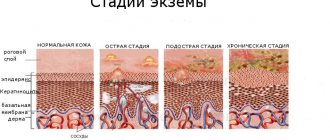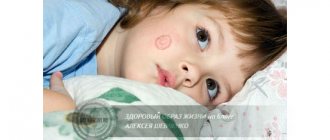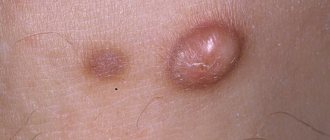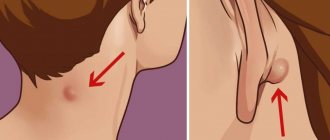Herpes zoster (herpes zoster, zoster virus) is a severe dermatological disease caused by the varicella zoster virus, in which patients develop vesicular rashes in the areas where the nerve branches are located.
Shingles in children is not a common pathology. So, according to medical statistics, today only 1 child out of 3-3.5 thousand suffers from this form of the disease. This disease can develop in newborns (especially if the child’s mother suffered from herpes in the 3rd and/or 4th trimester of pregnancy). In addition, if during childbirth a woman had herpetic eruptions in her genital tract, it means that the child was also infected with the herpes virus.
Risk factors
As a rule, herpetic rashes in newborns occur 7-10 days after infection. Moreover, the disease often affects only certain parts of the body (for example, the eyes), while all other areas remain healthy. The duration of the disease in this case is 10-15 days. Unlike adult patients, small children are extremely difficult to tolerate herpes zoster (premature children suffer the most from herpes). As practice shows, 70% of children develop severe complications as a result of a herpetic infection.
As for children of school and senior preschool age, in this case the disease develops only with a strong decrease in immunity. That is why patients at risk for the disease are those who:
- often suffer from colds;
- have chronic diseases of internal organs;
- suffer from cancer;
- recently underwent an organ transplant;
- infected with HIV.
After a child has chickenpox, the virus will remain in his body forever.
However, the number of viral particles in a healthy person is very small, since the body that has had herpes once constantly produces antibodies that kill the virus and thus prevent it from multiplying. All this time, single viral particles are in an inactive state in the nerve ganglia of the brain and spinal cord (immunity cannot eliminate the virus that is inside the cell).
However, with a strong decrease in immunity, the virus is activated and increases its reproduction. It is for this reason that shingles is more often diagnosed in children over 10 years of age. If a healthy child comes into contact with someone who has shingles, the child will most likely develop chickenpox.
Causes of the disease
Shingles in a child is a serious disease caused by the herpes virus type 3. This type of virus is found in almost every person, regardless of age category. It stays in the child’s body for quite a long time, showing absolutely no signs of itself, waiting for favorable circumstances that will allow it to become more active. A decrease in the body’s protective properties significantly contributes to the awakening of the virus and its active pathological activity.
Those most susceptible to herpes zoster are:
- newborns;
- children suffering from viral or various infectious diseases;
- carriers of HIV infection;
- patients who have been diagnosed with a malignant tumor.
The likelihood of infection increases significantly in crowded places. With a weak immune system, the disease develops much faster.
The main location of the causative agent of the disease is the nerve ganglia. The active activity of the herpes virus type 3 has a detrimental effect on the nerve cells and skin of children.
Today in medicine there is a wide variety of factors that favor the development of the inflammatory process, among which the following should be highlighted:
- prolonged emotional experiences and psychological stressful situations;
- the presence of a disease of viral or bacterial origin;
- hypothermia of the body;
- intense exposure to sunlight on the body.
The course of the disease, as well as the risk of complications, is largely explained by the state of the child’s immune system.
If the body’s protective properties are weak, the inflammatory process can manifest itself not only on the skin and mucous membranes, but also in the tissues of internal organs.
Symptoms
Shingles is extremely difficult to diagnose in the initial stages. As a rule, a visible sign of the disease - a rash - occurs after the immune system stops fighting the virus. At the same time, in the initial stages, the symptoms of lichen may resemble the manifestation of a common acute respiratory infection, because it has the following symptoms:
- weakness;
- increased body temperature;
- increased size of lymph nodes;
- burning, tingling and itching of the skin in places where rashes will appear in the future;
- loss of appetite.
It is worth saying that symptoms may differ slightly in different children. For example, in some patients the rash appears immediately, without a previous fever.
During the course of shingles, a child may also have symptoms:
- inflammation of the mucous membrane of the eye;
- stomatitis;
- inflammation of the cornea of the eye;
- inflammation of the lining of the brain.
Signs of herpes zoster
As a rule, rashes in adults and children are localized on the face and back, on the head and legs, arms and neck. The rash may be blistering, or have the appearance of small red pimples, somewhat reminiscent of scarlet fever.
Symptoms of herpes zoster (shingles) are often expressed as:
- severe weakness, lethargy, loss of strength;
- migraines, or intense headaches;
- general intoxication of the body, accompanied by nausea, vomiting, chills;
- rapid fatigue;
- increased body temperature;
- dyspeptic disorders;
- burning, tingling, tingling, itching at the site of the rash. As a rule, they are located in those areas where important nerve plexuses and trunks pass.
Viruses penetrate the skin nerves and appear as blisters
After the disease has been transferred (if it occurs in the patient for the first time), a long period of remission begins (that is, the disease ceases to bother the person, passing into a state of “sleep”, while the virus is still present in the tissues). And only in extremely rare cases can a relapse, that is, re-infection, occur.
Along with these signs, symptoms accompanying herpes rashes also appear. Acne has its own periods of ripening and manifestation. Unlike labial or genital herpes, herpes zoster has only 2 stages of development.
Initial stage. Red spots appear on the surface of the epidermis, which over time occupy a large area.
The second phase is the period of appearance of blistering rashes, which cause a lot of discomfort, especially at night. Often the rash is accompanied by enlarged lymph nodes and pain when pressing on them.
Since herpes zoster affects nerve tissue, patients, in addition to the main symptoms, may suffer from
- severe paroxysmal pain syndromes, worsening at night;
- increasing or, conversely, decreasing skin sensitivity in areas affected by rashes;
- paresis of muscles located next to diseased nerve tissues.
Attacks of neuralgia can be observed in a patient not only during the acute course of the disease, but also for several weeks or even months after completing a course of therapy. This is due to the fact that the virus resides too deeply in nerve cells, gradually causing their destruction, thereby reducing the effectiveness of antiviral drugs and interfering with normal tissue repair.
Care during illness
Children suffering from shingles should avoid taking baths. During the active phase of the disease, the child needs to carry out only the most necessary personal hygiene measures. To prevent a fungal infection from joining shingles, the child is advised to avoid ultraviolet rays.
For a speedy recovery, the child’s diet should include as many protein foods, vegetables and fruits as possible.
It is better to use underwear and bedding made from natural materials (preferably cotton), since synthetics provoke increased sweating and, as a result, the spread of infection to healthy areas.
It is very important to explain to your child that you should not scratch the rash. In this case, newborn children need to be constantly monitored. To prevent healthy people from becoming infected, the infected child should be isolated.
Symptoms of the disease in children
The disease manifests itself acutely and abruptly - a child can fall asleep completely healthy, and wake up with a fever and characteristic pain in the area of the affected nerves. By the end of the day, bubbles appear in this area, formed into groups that form literally before our eyes. The main symptoms of the disease are:
- rashes in the form of blisters filled with liquid against a background of thickened, reddened skin located over damaged nerves, localized along the ribs on the back and chest. Around 3-4 days, the blisters burst, forming small but aching ulcers, which dry out as the child recovers;
- high body temperature, as with chickenpox, which can reach 39.6-39.9°C;
- a strong feeling of itching along the nerves that are affected by the virus;
- intoxication and dehydration caused by high temperature;
- weakness, severe malaise;
- enlargement of the cervical, inguinal and necessarily axillary lymph nodes;
- severe pain that makes it painful to lie down, sit and stand. Her whining nature makes the child capricious and causes insomnia, so parents should be especially careful at this time and be patient.
In some cases, symptoms may be atypical. For example, the blisters take on a bullous form, and their contents have a hemorrhagic structure, a black scab can form under the blister, and the rarest type of manifestation of this form of herpes is the appearance on the body of not only localized rashes, but also blisters scattered throughout the body. But complex neuralgic complications of herpes zoster in children are extremely rare, and neuralgic symptoms also rarely appear after the rash disappears (and in adult patients, neuralgic exacerbation can drag on for many months).
Diagnostic measures and principles of treatment of childhood herpes zoster The doctor can make a diagnosis after a detailed examination of his little patient, examining the rashes - they are very typical and characteristic only of this disease. But in order to determine the stage of the disease and the degree of its complexity, the doctor may prescribe an additional laboratory test of blood, as well as fluid taken from the vial. An additional study could be a blood test for HIV, because in our time parents, without knowing it, could transmit the virus to their child during pregnancy (if they themselves did not know about their status). Treatment of herpes zoster should be comprehensive, combining external and internal medications. In addition, the baby is indicated for home quarantine for 14-21 days, since during this period he is an active carrier of herpes. In the case of a very severe illness, the child may be assigned to stay in the infectious diseases department of the hospital. Conventional antiherpes drugs, such as acyclovir, have proven themselves to be effective. Valtrex, Herpevir, Famvir. The only condition is that the dosage of the drug must be selected correctly, depending on the age or weight of the child. The course of taking the medication ranges from 5 days to a week. In some cases, the doctor may prescribe not only antiviral drugs, but also antibiotics, for example, Rondomycin. Salicylates and medications that can eliminate swelling of the nerve endings are also necessarily prescribed. The blisters themselves should be treated twice a day with brilliant green and antiviral ointment (for example, herpevir or Zovirax), and to speed up the healing of wounds, the doctor may prescribe rubbing based on interferon or laferon. Please note that wiping should be targeted, since it is impossible to wet the area of the body with the disease. And if a child gets sick in the summer, it is better to expose the affected area, since contact with clothing causes additional pain. If your child experiences severe pain, the doctor may prescribe painkillers, such as Nurofen or ibuprofen. In the first days, an injection of analgin and diphenhydramine may be prescribed, which will not only calm the pain, but also allow the child to fall asleep. After the disease subsides, the child should be prescribed a course of vitamins and medications that stimulate the immune system. Treatment should be carried out under the strict supervision of a doctor, since all drugs used during therapy can cause a lot of side effects.
What does shingles look like on a child's body?
Treatment
If herpes zoster has been diagnosed in children, treatment will be the same as for adult patients.
Treatment for herpes zoster should ideally begin within the first 72 hours of the onset of symptoms. It should continue for a week, and then 2 more medications are recommended to be used for prophylactic purposes.
There are many medications that can destroy the herpes virus. They have different names, but they have the same main active ingredient - Acyclovir. The daily dose of this substance for a child under 1 year is 30 mg per 1 kg of weight. The medication is taken 3 times a day. However, in more severe cases, Acyclovir is administered intravenously in an amount of 1500 mg/ml. The sooner Acyclovir is used, the less likely there will be relapse and complications, and the faster the signs of the disease will disappear.
Patients with mild herpes can take Acyclovir orally at a dose of 800 mg. The dose should be divided into 5 times a day.
Patients with weakened immune systems may be prescribed Ribavirin. The administration of this drug should be slow (over 12 hours). The average dose of Ribavirin in patients suffering from herpes zoster is 15 mg/kg.
To stimulate the immune system, immunoglobulin can be used in an amount of 0.2 ml/kg of body weight. This drug should be administered once. In very severe cases, the dose of immunoglobulin can be increased 2-4 times.
In addition to systemic medications, topical medications can be used for shingles. As a rule, they also include Acyclovir and interferon. To reduce pain, the doctor may prescribe painkillers, anti-inflammatory drugs and tranquilizers.
To quickly eliminate discomfort, novocaine blockades (a procedure during which an anesthetic solution is injected into the affected area using a syringe), as well as electrophoresis, can be used.
It is very important that the condition of a sick child is constantly monitored by the attending physician. Only he knows the symptoms and treatment of lichen reliably. At the same time, self-indulgence can lead to even more dire consequences than the lack of medical care.
How to identify it and choose the right treatment?
There are several types of this disease in children:
- herpes zoster virus (same as shingles);
- herpes zoster in tandem with meningitis;
- herpes zoster virus coupled with encephalitis;
- herpes zoster virus with complications on the eyeballs;
- herpes zoster virus with complications on the nervous system;
- uncomplicated herpes zoster virus.
The herpes zoster virus (shingles) usually affects children, but there have been cases where this disease was diagnosed in adults who had chickenpox in early childhood.
But they can become infected with shingles directly at an older age, or already as a teenager. This infection may appear as ulcers on a specific area of the skin. Dermatologists note that children under ten years of age almost never suffer from this disease.
Prevention
To prevent herpes zoster in children, it is recommended:
- exclude the child’s contact with stray animals or patients with herpes zoster;
- accustom the child to personal hygiene;
- regularly take your pet for preventive examination to the veterinarian;
- dress appropriately for weather conditions.
In addition, it is very important to carry out various activities aimed at strengthening the immune system. For example, harden yourself, play sports, take vitamin and mineral complexes. In order for a child’s body to be strong, it must eat a balanced diet, sleep enough hours and not be exposed to stress.
Prevention of herpes zoster
To prevent the herpes virus from entering the human body, you need to pay attention to:
- Boosting the immune system.
- Maintaining a healthy lifestyle (proper nutrition, hardening).
- Dress your child appropriately for the weather to avoid hypothermia or overheating.
- If desired, carry out active immunization with weakened varicella-zoster viruses.
- In case of infection, isolate the sick person from others. Then ventilate the room and carry out wet cleaning.
- Passive immunization is the introduction of a specific immunoglobulin.
The prognosis for adequate treatment of herpes zoster is generally favorable. The child recovers quickly, complications are rare. Protect your sick child from others: the virus is very contagious, especially for people who have not had chickenpox. Don't forget to protect yourself and strengthen your immune system. Simple rules of prevention and timely treatment will help you survive the disease without complications.

